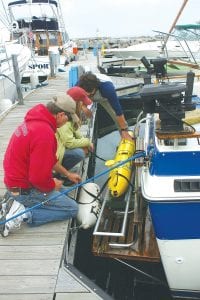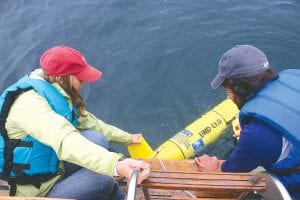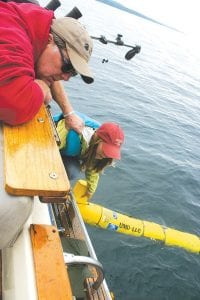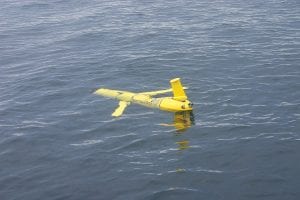Bon voyage, Gitchi Gami! On Tuesday, June 19, researchers with the University of Minnesota-Duluth Large Lakes Observatory (LLO ) launched the Gitchi Gami, a submersible glider that collects data on its travels underwater. Captain Dave Williams helps Assistant Scientist Matt James and UMD graduate student Betsy Welsh load the glider onto the swim platform of his charter boat Fishin’ Chicks.

The people who board the charter fishing boat Fishin’ Chicks are usually in search of fish. On Tuesday, June 19, the charter boat’s passengers were in search of data. Charter boat Captain David Williams helped researchers launch a bright yellow submersible which will travel from Grand Marais to Ontonagon, Michigan to collect information on Lake Superior.
The submersible, launched by University of Minnesota – Duluth Assistant Scientist/Oceanographer Matt James and UMD graduate student Betsy Welsh of the Large Lakes Observatory (LLO), is one of only 200 such devices in use. The torpedo-like device is primarily used in oceans. The one deployed this week just west of Five Mile Rock in Grand Marais is one of the only ones being used in the Great Lakes and the first used in Lake Superior. Welsh said all of the submersibles, or “gliders,” have names and the one being used on Lake Superior is named, appropriately, Gitchi Gami.

Above: Betsy Welsh and Matt James prepare to launch the Gitchi Gami into Lake Superior. Left: After being launched, the Gitchi Gami floated for only a few minutes and then slowly began its dive. The bright yellow, torpedo-shaped glider will quietly do its work about 20 feet below the water’s surface until it is recovered on June 29.
Gitchi Gami was used in previous years on Lake Superior’s south shore, making the trek between Knife River and Brule Point, Wisconsin to collect information about the lake.
The Gitchi Gami will make its way to Ontonagon, Michigan at a speed of ½ a knot. It will make the trip twice before the researchers aboard the Fishin’ Chicks pick it up again on June 29. As it travels, instruments on the glider will record the water temperature, conductivity, depth, chlorophyll fluorescence, dissolved oxygen, water clarity, and CDOM (colored dissolved organic matter).
The 52-kilogram device is self-propelled, using buoyancy created by an air bladder in the glider’s tail and a piston to fill the nose cone with water. The combination causes the glider to make a 26-degree descent. It is able to dive as deep as 200 meters. An altimeter monitors the movement and when the Gitchi Gami reaches that depth—or if it gets closer than 10 feet from the bottom of the lake—it climbs back up to 18 – 20 feet below the surface of the water.
At certain preset GPS waypoints and once every six hours the submersible comes to the surface and, like the alien of E.T. fame, “phones home.” Home is wherever the researchers are and the information is sent via the Internet. “It text messages us,” said Betsy.
The check-ins are important, as none of the data collected can be sent while the Gitchi Gami is underwater. The message lets researchers know that the glider has been working properly, recording all the data it is supposed to when it is out of contact. “It says ‘here I am’ or ‘I’m not okay, come get me,’” explained James.
“It could send a message such as ‘My batteries are low, I’m not going under,’” he said. The research team then uses the GPS coordinates in the message to find and retrieve the device.

Captain Dave Williams of Fishin’ Chicks Charters grasps UMD grad student Betsy Welsh’s life jacket for safety as she helps lower the Gitchi Gami submersible glider into Lake Superior. Welsh and Assistant Scientist Matt James will stay in contact with the glider as it collects valuable information on Lake Superior.
If all is well, after three minutes, the glider dives again and continues on its way. Satellite signals provide direction, but since they cannot be received under water, the submersible can be pushed off course by lake currents. If that happens and the Gitchi Gami comes to the surface off-course, it calculates the effects of the current and adjusts course.
It would be disastrous to lose the Gitchi Gami—the device costs $100,000. However, James said it is unlikely that one would get lost. “They are pretty robust,” he said.
There is even a failsafe built into the glider in case it becomes trapped underwater somehow. After a long period underwater (20-30 hours), and numerous attempts to return to the surface, the device activates a launching mechanism in its rocket-like tail. It sends an electrical current to the tail, which burns through a wire holding a spring. The spring releases and propels the glider to the surface.
Researchers ask anyone who sees the Gitchi-Gami to leave it alone. Since it seldom surfaces, it is not very often that people on the lake encounter the glider. However, it has happened. James said a couple of fishermen once plucked one out of the water. “We were very confused,” said James, noting that the glider sent messages that it was unable to dive.
“All we knew was that something was not right,” said James. As the scientists tried to figure out what was going on, the fishermen, who called the phone number painted on the side of the glider and said, ‘We’ve got your thing here.’”
Researchers collected the device, repaired one of its carbon fiber “wings”—an expense of $500—and launched it once again. The $100,000 price tag for the glider may seem high. However, Dr. Jay Austin, director of the UMD LLO noted that in the long run, it is a cost-saving device. He said it would cost much more for a manned research vessel to collect the same data. He said it costs less than $100 a day to operate the glider. And, said Dr. Austin, the information gathered by the glider is invaluable.
Welsh said she has used the data collected to conduct workshops with teachers, who are thrilled to have such comprehensive information for students. Welsh said eventually a website will be developed to share the information discovered about the lake with the general public.
In the meantime, if you’re fishing on the Big Lake and something bright yellow and torpedo-shaped comes splashing to the surface alongside you—leave it alone. It’s a glider hard at work for the Large Lakes Observatory.



Loading Comments